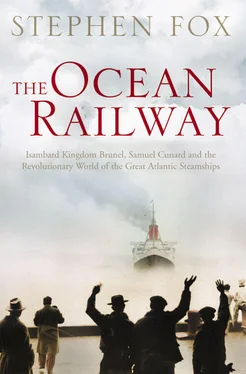1 ...6 7 8 10 11 12 ...38 With Boulton in the background, prodding and executing, Watt made further improvements, notably a double-acting cylinder whereby steam alternately drove the piston in both directions, yielding two power strokes in each cycle. He also devised linkages and gearings to convert the piston’s in-and-out reciprocating action to a rotary motion that could power the machinery of mills and factories. ‘ The peoplein London, Manchester, and Birmingham, are Steam Mill Mad,’ Boulton advised Watt, ‘and therefore let us be wise and take the advantage.’
Amid his great success, Watt never stopped fretting about competitors and potential patent infringers. To protect himself and his inventions from the onrushing progress of modernity, he grew defensive and started resisting improvements. He quashed innovations in his own shop (especially efforts to raise boiler pressures and efficiencies beyond a modest four pounds per square inch), refused to license others to use his refinements, and hounded anybody else who dared to build a steam engine. The exploding genie of constant, rapid technological change – which his steam engine had midwifed – finally turned and overwhelmed him. ‘ I do not thinkthat we are safe a day to an end in this enterprizing age,’ he warned Boulton in 1782. ‘One’s thoughts seem to be stolen before one speaks them.…It is with the utmost difficulty I can hatch anything new.’ Beset by this immobilizing difficulty, losing his fragile nerve, he stopped trying. But his engine and its revolutionary impacts steamed ahead, gathering speed.
From the 1780s on, various lone inventors in France, Great Britain and the United States tried to create a steamboat. For the propelling device, some of these pioneers used an application of the familiar waterpower wheel, which converted a stream of water into rotary motion to run a mill or factory: instead of water moving the wheel, the process was reversed so the engine-driven paddle wheel moved the surrounding water and thus the boat. But a paddle wheel was only one of several unsatisfactory earlyalternatives. Other propelling mechanisms given trials included a set of vertical oars that imitated manual rowing action (by the American John Fitch, in 1786), a jet of water forcefully expelled at the stern (by another American, James Rumsey, in 1787), and palmipedes, or duck-footed paddles (by the Earl of Stanhope, in London in 1790). None of these early attempts worked very well or led to any ongoing commercial success. Their inventors tinkered in general isolation from each other, without knowing about or profiting from what their predecessors had done. Steamboats as yet lacked a chain of invention.
William Symingtonstarted such a chain through his own inventions and by their later impact on others. He was another Scotsman, born in 1764 in Lanarkshire, south of Glasgow. Educated for the ministry, he was instead caught up in the inventive currents then starting to swirl around southern Scotland. ‘ My natural turnfor mechanical philosophy led me to change my object,’ he recalled, ‘and to direct my studies to the exercise of the profession of a civil engineer.’ He made some improvements in the steam engine – earning the suspicion of James Watt – and crafted a model of a steam carriage for road travel. This model brought him to the attention of Patrick Miller, a retired Edinburgh banker who had devised a manually powered paddleboat.
In 1788 Miller hired Symingtonto build and install a steam engine in this vessel. Symington used his own design, an engine with two cylinders of four-inch diameter and eighteen-inch stroke. A second version with a larger engine had a successful trial a year later, carrying seven passengers at five miles an hour. But this success drew potential legal action by the ever-vigilant Watt for alleged patent infringement. After Miller lost interest in the experiments and withdrew his financial support, Symington dropped his steamboat efforts for a decade and made a living by building mining machinery.
The expiration of Watt’s patent in 1800 released a flood of pent-up inventive energy. Thomas, Lord Dundasof Kerse, a large shareholder in the Forth and Clyde Canal, remembered Symington’s experiments of the late 1780s. The canal, completed in 1790, stretched thirty-five miles from the River Forth near Edinburgh to the River Clyde near Glasgow, providing a water link across Scotland between the Atlantic Ocean and the North Sea. The canal’s average width of about fifty-six feet left little room for a sailing vessel to tack back and forth, so most of the barge traffic was drawn by horses along a tow path. Lord Dundas provided Symington initial seed money for a canal steamer.
In June 1801, Symington’s first new prototype ran successfully for two or three miles on the River Carron to Grangemouth. ‘ The nice and effectualmanner in which the machinery is applied,’ a Glasgow newspaper commented, ‘is an additional proof of the merit of Mr Symington, the engineer, and the whole plan is highly honourable to Lord Dundas.’ That autumn Symington patented his novel arrangement of a connecting rod and crank between the engine and paddle wheel shaft.
A second prototype, larger and more powerful, was named the Charlotte Dundasafter the sponsor’s wife and daughter, who shared the name. The vessel was a broad-beamed towboat, fifty-six feet long by eighteen feet wide, powered by a one-cylinder engine driving a paddle wheel in a recess at the stern. The engine was built at a local foundry, the Carron Works, with a piston twenty-two inches in diameter and a four-foot stroke: an enormous increase over Symington’s first steamboat engine of 1788. His solution to the besetting early problem of paddle wheels – the dilemma that drove other pioneers to water jets and palmipedes – was to elevate the wheel quite high above the water. When a wheel was submerged to its midpoint, half in and half out of the water, much of its driving motion was wasted. A paddle entered the water in a horizontal position, slapping downward, and did no useful propelling work until it had run through almost forty-five degrees of its rotation. Only at the bottom of the cycle was it actually propelling the boat forward. On the back stroke, the process was reversed, as for the final forty-five degrees the paddle pushed largely upward until it cleared the surface. About half its energy simply thrashed the water up and down to no purpose. To avoid this waste, Symington placed the eight-bladed wheel of the Charlotte Dundas so high in the hull that only three of the paddles reached the water at once, at the bottom of the cycle, all of them working together to move the boat forward.
As Symington later told the story, in March 1802 the Charlotte Dundas took on board Lord Dundas, his son Captain George H. L. Dundas of the Royal Navy, and others, and towed two loaded vessels of seventy tons each a distance of nineteen and a half miles along the canal in six hours, against a strong head wind. ‘ This experimentnot only satisfied me, but every person who witnessed it, of the utility of steam navigation, ’ Symington later wrote. But the canal proprietors worried that the steamboat’s agitation and wake would harm the banks of the canal, and so rejected the plan. Lord Dundas then arranged for Symington to meet the Duke of Bridgewater, the leading canal entrepreneur in England. The duke at once ordered eight of Symington’s vessels – but he soon died, cancelling the deal. This double rejection after apparent successes left Symington too disheartened to persist. ‘ This so affectedme,’ he recalled, ‘that probably I did not use the energy I otherwise might have done to introduce my invention to public notice.’
This version of events has become the standard historical account, but it is wrong in certain particulars. Drawing from memory some twenty-five years later, Symington compressed two separate trials into a single event. On 4 January 1803, the Charlotte Dundas, with the two Dundases and others on board, towed a 100-ton boat from Stockingfield to Port Dundas at three miles an hour ‘ amidst a very largeconcourse of people’, according to a newspaper report, ‘who were exceedingly well pleased with the performance.’ On 28 March 1803, the steamboat also towed two loaded vessels, a combined 130 tons, from Lock 20 on the canal to Port Dundas, eighteen and a half miles in nine hours and fifteen minutes – a speed about 40 per cent slower than Symington later remembered. For this trial he had incorporated suggestions by Captain George Dundas for how to manage the tow lines around sharp bends in the canal. The Glasgow Herald and Advertiser praised ‘ the very appropriatemode in which the machinery is constructed, and the simple yet effectual manner its power is applied in giving motion to the vessel’. The newspaper also credited Lord Dundas for his generous financial support and perseverance in the ‘costly experiments’.
Читать дальше












